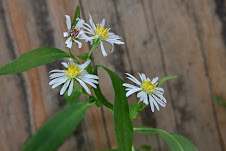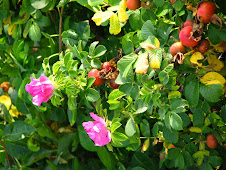The wild flower called Tufted Knotweed (Polygonum caespitosum var.longisetum) or long-bristled smartweed is in the buckwheat family (Polygonaceae), which is also known as the knotweed family. Polygonum is Greek for many knees or many joints.
Leaves are arranged alternately along the stem, lanceolate to elliptic in outline, approximately 3/4 to 3 inches long and 1/2 to 1 1/4 inches wide. Older leaves are usually only slightly hairy. The leaves taper to short petioles, which have an ocrea which encircles the stem. Leaves often, but not always, have a purple spot in the middle of the leaf.
Knotweed has fibrous roots with a shallow and branching taproot. The stems are branched, often reddish in color and swollen at the nodes. A thin membranous sheath called an ocrea encircles the stem at the base of each leaf petiole. The ocrea's of tufted knotweed have stiff hairs arising from the top of the ocrea, which are from 5 to 10 mm long.
The blooming period occurs during the summer and early fall, and can last 2-3 months for a colony of plants. Flowers are clustered in terminal spikes at the ends of stems. Individual flowers are small and are dark pink to red in color. Each flower is replaced by a 3-angled seed that is black and shiny, tapering to blunt points at the upper and lower ends. This plant can reproduce by forming rootlets near the ochreae of the leaves. It also reproduces by reseeding itself.
This weedy plant isn't fussy about growing conditions. It can be found in full sun to light shade, moist to dry areas, and various kinds of soil, including those containing loam, clay loam, and rocky or gravelly material. Some of the lower leaves may shrivel away during hot dry weather. This smartweed withstands regular lawn-mowing better than others because of its low-growing habit.
There are about 35 species of smartweeds found in the east. Three smartweeds in our area are similar except for the stiff hairs on the ocrea or knee. The elliptic to lanceolate leaves with a purple spotted 'lady's thumb' print in the middle and distinctive ocrea with stiff hairs are all characteristics that help to distinguish tufted knotweed from other similar weeds. Pennsylvania Smartweed (Polygonum pensylvanicum) is very similar in appearance and growth habit, but does not have hairs on the knee like that of tufted knotweed. Lady’s Thumb (Polygonum persicaria) is also similar in appearance and growth habit, but has hairs on the knee that are much shorter (2 mm) and has generally smaller leaves and dark pink to red flowers.
As a wildflower smartweeds are a lovely blooming addition to your yard. Birds that eat the seeds of the Smartweeds include the Mourning Dove, English Sparrow, House Finch, other songbirds, and ducks.
Leaves, stems and flowers are edible, but very hot. Try a small part of leave about ¼ size of your little finger nail. Wait a second or 2 then you will taste the heat. Good substitute for pepper or wasabi in your cooking, but use sparingly. The plant can be used fresh or dried. It’s a fine plant for seasoning while camp cooking, but can overwhelm like cayenne pepper. Also be careful because some people can develop dermatitis from it.
There is a tradition, quoted in old Herbals, that if a handful of the plant be placed under the saddle, a horse is enabled to travel for some time without becoming hungry or thirst.
Subscribe to:
Post Comments (Atom)



















LP_gardening_2666.jpg)
LP_gardening_2668.jpg)

LP_garden_2819.jpg)

LP_flower_0563.jpg)
LP_flower_0577.jpg)
LP_flower_0545.jpg)
LP_flower_0555.jpg)
LP_flower_0539.jpg)
LP_dog_0470.jpg)
LP_snow_0467.jpg)
LP_dog_0349.jpg)
LP_tree_8153.jpg)
LP_5028.jpg)
LP_flowers_3940.jpg)

LP-grass_0889.jpg)
LP_redfox_1651.jpg)
LP_squirrel_6978.jpg)
LP_flower_6936.jpg)
LP_squirrel_6864.jpg)
LP-deer_4773.jpg)
LP_4521.jpg)
LP_1251.jpg)
LP_4585.jpg)
LP_3784.jpg)
LP_3759.jpg)
LP_3811.jpg)
LP_3816.jpg)
LP_3847.jpg)
LP_0870.jpg)
LP_4183.jpg)
LP_0891.jpg)
LP_3175.jpg)
LP_3577.jpg)

LP_3068.jpg)
LP_3058.jpg)
LP_3562.jpg)
LP_0118.jpg)
LP_3407.jpg)
LP_3150.jpg)
LP_3011+(2).jpg)
LP_3020.jpg)
LP_2830.jpg)
LP_2782.jpg)
LP_2828.jpg)
LP_1746.jpg)
LP_2648.jpg)
LP_2666.jpg)
LP_2668.jpg)
LP_2493.jpg)
LP_2611crop.jpg)


LP_2588.jpg)






LP_2126.jpg)
LP_2122.jpg)






No comments:
Post a Comment